Life Sciences P2 Grade 12 Questions - NSC Exams Past Papers and Memos September 2019 Preparatory Examinations
Share via Whatsapp Join our WhatsApp Group Join our Telegram GroupINSTRUCTIONS AND INFORMATION
Read the following instructions carefully before answering the questions.
- Answer ALL the questions.
- Write ALL the answers in the ANSWER BOOK provided.
- Start the answer to EACH question at the top of a NEW page.
- Number the answers correctly according to the numbering system used in this question paper.
- Present your answers according to the instructions of each question.
- ALL drawings MUST be done in pencil and labelled in blue or black ink.
- Draw diagrams, tables or flow charts ONLY when asked to do so.
- The diagrams in this question paper are NOT necessarily drawn to scale.
- Do NOT use graph paper.
- You must use a non-programmable calculator, protractor and a compass, where necessary.
- Write neatly and legibly.
QUESTIONS
SECTION A
QUESTION 1
1.1 Various options are provided as possible answers to the following questions. Choose the correct answer and write only the letter (A–D) next to the question number (1.1.1–1.1.10) in the ANSWER BOOK, for example 1.1.11 D.
1.1.1 DNA replication takes place in the …
- cytoplasm during prophase.
- nucleoplasm during interphase.
- cytoplasm during interphase.
- nucleoplasm during prophase.
1.1.2 Which pair of statements below is a correct difference between mitosis and meiosis?
MITOSIS | MEIOSIS |
The chromosome number remains constant | The chromosome number is halved |
Homologous chromosome pairs form during prophase | No homologous chromosome pairs form during prophase |
The cytoplasm divides twice | The cytoplasm divides once |
Daughter cells are different from each other | Daughter cells are identical to each other |
1.1.3 The diagram below shows 6 chromosomes (labelled a–f) from a diploid cell.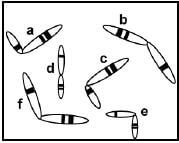
Which of the following combinations represent the 3 pairs of homologous chromosomes?
Homologous pair 1 | Homologous pair 2 | Homologous pair 3 |
c and d | a and f | b and e |
a and c | d and e | b and f |
a and e | c and d | b and f |
a and d | b and c | e and f |
1.1.4 Four different phenotypes are possible in the F1 generation if the parents’ blood types are …
- A and B.
- AB and AB.
- A and A.
- AB and O.
1.1.5 The key below shows the main components of a DNA molecule and the strength of the bonds that hold them together. 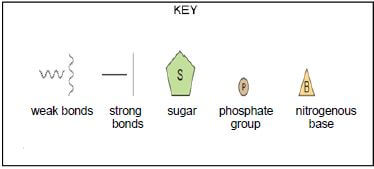
Which one of the following diagrams shows the correct combination of components of a DNA molecule?
1.1.6 The police were called to a scene where a man was seriously injured in a fight. They found blood on the man’s hands that was not his own. The police took a sample of this blood as well as samples from the victim and three suspects (1 to 3) who were suspected of injuring the man.
The results are shown below:
Which suspect was definitely at the crime scene?
- 1
- 2
- 3
- None of the suspects
1.1.7 Which of the following supports the ‘Out of Africa’ theory?
- Homo habilis was the first hominin to use tools
- The African Apes share many characteristics with humans
- Comparing mutations on mitochondrial DNA
- Homo erectus fossils found in Europe
1.1.8 The table below shows the anti-codons of tRNA that code for different amino acids found in human protein.
ANTI-CODONS OF tRNA | AMINO ACIDS |
CAA | Valine |
CCC | Glycine |
CGU | Alanine |
AAA | Phenylalanine |
UCG | Asparagine |
UAC | Methionine |
GGU | Proline |
AGC | Tryptophan |
UCA | Serine |
What is the corresponding amino acid for the DNA base triplet TCG?
- Alanine
- Tryptophan
- Serine
- Asparagine
1.1.9 The graph below shows the mass of DNA found in a cell over time.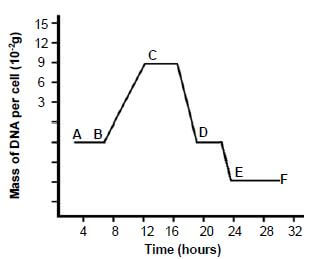
Interphase takes place between …
- A and B.
- B and C.
- E and F.
- A and C.
1.1.10 Study the diagram below.
Which conclusion can be drawn from the above diagram?
- Homo sapiens is a direct descendant of Ardipithecus ramidus
- Homo sapiens evolved from chimpanzees
- Australopithecus africanus is a common ancestor of all Homo species
- Homo sapiens and Homo erectus have the most recent common ancestor
(10 x 2) (20)
1.2 Give the correct biological term for each of the following descriptions. Write only the term next to the question number (1.2.1–1.2.8) in the ANSWER BOOK.
1.2.1 Organisms that have two identical alleles for a particular characteristic
1.2.2 The scientist who proposed the principle of independent assortment
1.2.3 Factors that prevent members of different species from producing fertile offspring
1.2.4 Undifferentiated animal cells that have the ability to change into any cell type
1.2.5 The shape of a DNA molecule
1.2.6 Phase in cell cycle when DNA replication occurs
1.2.7 Having an upper or lower jaw that projects abnormally forward
1.2.8 Genetic condition resulting in having an extra chromosome 21 (8 x 1) (8)
1.3 Indicate whether each of the statements in COLUMN Ι, applies to A ONLY, B ONLY, BOTH A and B, or NONE of the items in COLUMN ΙΙ. Write A only, B only, both A and B, or none next to the question numbers (1.3.1–1.3.3) in the ANSWER BOOK.
COLUMN Ι | COLUMN ΙΙ |
1.3.1 Blood types |
|
1.3.2 Heterozygous condition expresses both alleles in gene pair |
|
1.3.3 Complete set of chromosomes in one cell |
|
(3 x 2) (6)
1.4 The diagram below represents 3 phases of a cell division process.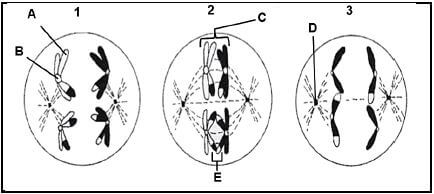
1.4.1 Name the type of cell division shown in the diagram above. (1)
1.4.2. State the:
- Process that has taken place at E (1)
- Organ in a male animal where this type of cell division occurs (1)
1.4.3 Label parts:
- A (1)
- B (1)
- C (1)
- D (1)
1.4.4 Identify phase:
- 2 (1)
- 3 (1)
1.4.5 How many chromosomes will there be in each cell at the end of the cell division process indicated in the diagram above? (1) (10)
1.5 In sheep, the allele for black wool (B) is dominant over the allele for white wool (b). Similarly, the allele for horns (H) is dominant over the allele for being hornless (h). A horned sheep with black wool was crossed with a pure breeding hornless sheep with white wool.
The Punnett diagram below shows the result of this cross.
SHEEP 1 ⇒ SHEEP 2 ⇓ | BH | Bh | bH | bh |
bh | Y | |||
bh | X | |||
bh | ||||
bh |
1.5.1 State why the example above represents a dihybrid cross. (1)
1.5.2 Give the genotype for the horned sheep with black wool used in this cross. (1)
1.5.3 Give the:
- Genotype of offspring X (1)
- Phenotype of offspring Y (1)
1.5.4 If 32 offspring are produced, how many offspring are expected to have horns and white wool? (2) (6)
TOTAL SECTION A: 50
SECTION B
QUESTION 2
2.1 Study the diagram below.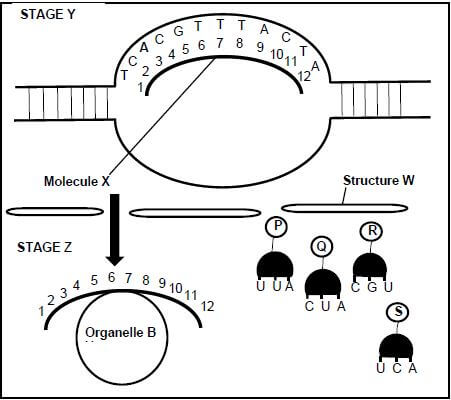
2.1.1 Name the process represented in the diagram above. (1)
2.1.2 Identify:
- Molecule X (1)
- Organelle B (1)
- Structure W (1)
2.1.3 Give the sequence of nitrogenous bases for the first codon on molecule X (1, 2, 3). (1)
2.1.4 Give the correct order in which molecules P, Q, R and S would attach to molecule X. (From left to right) (2)
2.1.5 Where in a cell does stage Z occur? (1)
2.1.6 Describe the process of transcription as seen in stage Y. (5)
2.1.7 If the third nitrogenous base (A) of the DNA strand was replaced by G, describe how this would affect the protein that will form. (4) (17)
2.2 Cystic fibrosis is a genetic condition that causes a build-up of thick sticky mucus in the lungs, pancreas, liver and intestines.
Study the diagram below of two families that carry the cystic fibrosis gene. The letters N and n are used to represent the two alleles.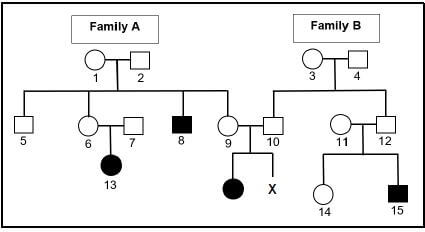
2.2.1 Define a gene mutation. (1)
2.2.2 Name the type of diagram shown above. (1)
2.2.3 How many generations are shown in the diagram? (1)
2.2.4 Using evidence from the diagram, explain why the gene for cystic fibrosis is a recessive allele.(3)
2.2.5 Individual 9 and individual 10 are expecting their second child X. Use a genetic cross to show the percentage chance of them having a child with cystic fibrosis. (6) (12)
2.3 Read the following extract.
| Duchenne’s muscular dystrophy is a genetic disorder in which the skeletal muscles progressively weaken. It is a sex-linked disorder. The recessive mutated gene codes for a weak form of protein which cause the muscle fibres to weaken and break down. Duchenne’s muscular dystrophy mostly affects boys and causes their muscles to weaken from the age of about 3. By the time they are teenagers they will be using a wheelchair and eventually their heart and respiratory muscles will also be affected. |
2.3.1 Define a sex-linked disorder. (1)
2.3.2 According to the extract, when will parents first notice the changes in the muscles of their child? (1)
2.3.3 Explain why is it more common for boys to suffer from Duchenne’s muscular dystrophy than girls. (4) (6)
2.4 Study the diagram below.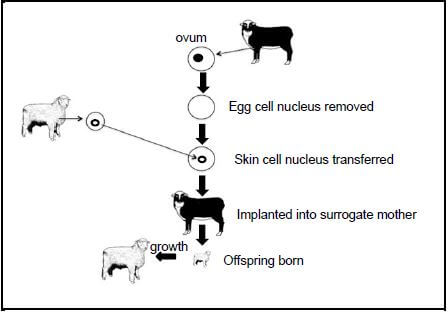
2.4.1 Name the process shown in the diagram above. (1)
2.4.2 Give TWO possible benefits of this process. (2)
2.4.3 Explain why the nucleus of a skin cell was used in this process and not the nucleus of a gamete. (2) (5) [40]
QUESTION 3
3.1 The diagram below shows the limbs of various animals.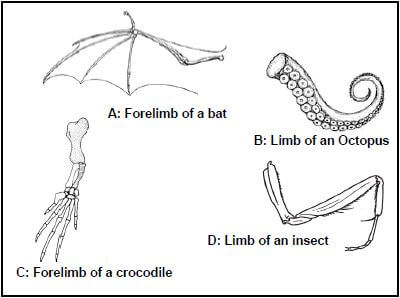
3.1.1 Give only the LETTERS of the diagrams that represent homologous structures. (2)
3.1.2 Describe how homologous structures provide evidence for evolution. (2)
3.1.3 Besides studying homologous structures, name TWO other sources that scientists use as evidence for evolution. (2) (6)
3.2 Study the diagram below showing evolution by natural selection in deer. 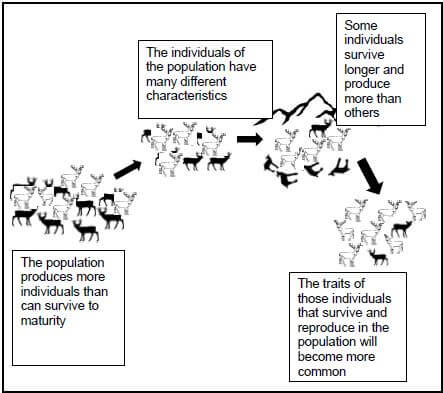
3.2.1 List THREE sources of variation in a species. (3)
3.2.2 Explain why the above example represents discontinuous variation. (2)
3.2.3 Both Darwinism and Punctuated Equilibrium explains evolution in terms of natural selection. Tabulate TWO differences between Darwinism and Punctuated Equilibrium. (5) (10)
3.3 The baobab tree belongs to the genus Adansonia. Different species are found in Madagascar, Africa and Australia as shown in the diagram below. Originally these three continents formed part of Gondwanaland as seen in diagram 1. Today the continents are separated by large oceans as seen in diagram 2.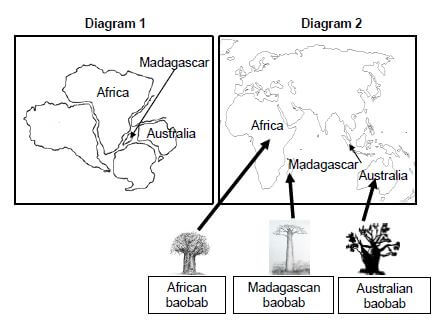
Explain how the different species of baobab could have evolved on the different continents. (6) (6)
3.4 Scientists wanted to investigate whether pure breed dogs are more likely to suffer from certain genetic diseases than mixed breed dogs.
The procedure was as follows:
- Five genetic diseases were investigated
- A total of 200 dogs that suffered from each genetic disease was used
- The number of pure breed dogs and mixed breed dogs suffering from each disease was recorded in the table below
- The whole investigation was conducted over a period of five years
Breed of dog | Number of dogs affected | ||||
Liver shunt | Hypo-thyroidism | Epilepsy | Cataracts | Lymphoma cancer | |
Mixed Breed | 22 | 38 | 40 | 42 | 50 |
Pure Breed | 178 | 162 | 160 | 158 | 150 |
NOTE:
- Pure breed dogs refer to dogs that are allowed to mate with dogs of the same breed only
- Mixed breed dogs refer to dogs that are allowed to mate with dogs from any breed
3.4.1 State the TWO independent variables in this investigation. (2)
3.4.2 Calculate the percentage of mixed breed dogs that suffered from cataracts. Show ALL your calculations. (2)
3.4.3 Give a conclusion for the above investigation. (2)
3.4.4 Draw a bar graph to show the data recorded in the table above on the same set of axes. (6)
3.4.5 State ONE way in which artificial selection differs from natural selection. (2)
3.4.6 Explain why all dogs are still considered one species although there are many different breeds. (2)
3.4.7 Based on the information collected in this investigation, explain what advice you would give to someone who asked you if artificial breeding is ethically correct. (2) (18)[40]
TOTAL SECTION B: 80
SECTION C
QUESTION 4
Changes took place in the skull and other parts of the skeleton from primitive apelike beings to modern humans.
Explain how these changes supports the evolution towards bipedalism. Also describe how changes in the skull supports the trend towards a change in diet, improved communication and the use of tools.
Content: (17)
Synthesis: (3)
NOTE: NO marks will be awarded for answers in the form of flow charts, tables or diagrams.
TOTAL SECTION C: 20
GRAND TOTAL: 150